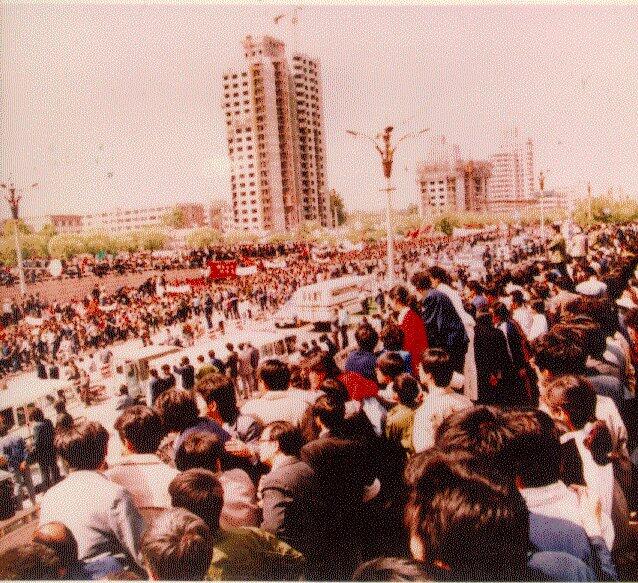
In April 1989, former general secretary and chairman of the Chinese Communist Party Hu Yaobang died of a heart attack. Hu advocated for political and economic reforms while in office.
He was forced to resign for taking a soft attitude towards the student protests in 1986. His death brought on the gathering of university students in large numbers in Beijing calling for affirmation of Hu’s view on democracy and freedom.
Within days, the student gatherings transformed into pro-democracy protests demanding freedom of the press and an end to corruption. Their demands drew wide public support. Workers and ordinary citizens joined in. Peaceful demonstrations took place in Beijing and throughout China.
On April 26, the People’s Daily, China’s largest official newspaper, published an editorial in 1989 that labeled the students’ assembly in Tiananmen Square as an “upheaval.” As tensions escalated in Beijing, martial law was declared on May 20.
On the night of June 3, heavily armed troops and hundreds of armored vehicles moved into Beijing to “clear” the pro-democracy demonstrators. Many unarmed civilians, including children and elderly people, were shot dead by troops.
By June 4, the troops took full control of Beijing. An official report issued by the Chinese authorities claimed that “more than 3,000 civilians were wounded and over 200, including 36 college students, died during the riot.” The report also claimed several dozen soldiers died. While the exact figures remain unknown, it is likely the official figures are too low.
Immediately after the military crackdown, the authorities began to hunt down those involved in the demonstrations. Many civilians were detained, tortured, or imprisoned after unfair trials. Over the years, the Chinese authorities have failed to bring those responsible for serious human rights violations to justice.
They also suppressed public debates and discussions of the events. Those seeking justice for the victims have suffered from police harassment, arbitrary detention and sometimes imprisonment. Others who attempted to commemorate the events of 1989 fell into the same fate.
Gu Yimin is among those who refused to forget Tiananmen. On March 24, 2014, Gu Yimin was sentenced to 18 months in prison. A court in eastern China found Gu Yimin guilty of “inciting subversion of state power” after he tried to post images of the crackdown online and applied to stage a protest for the 24th anniversary of the crackdown in 2013.
On December 23, 2011, Chen Wei was convicted of the same charge as Gu Yimin and sentenced to 9 years for 11 articles he had written in support of democracy and political reform. He was one of the leaders of the 1989 protests, for which he was imprisoned until January 1991.
Prior to the latest sentence, Chen spent five years in prison in the early 90s under the charge of “counterrevolutionary propaganda and incitement” for commemorating the anniversary of the crackdown and for organizing a political party.
The family members of those that were killed or went missing 25 years ago and the demonstrators that survived the crackdown and continue to struggle for human rights need to know they are not alone. As millions of internet users in China take great pains daily to bypass censors to access blocked websites including popular social media sites, we are recalling the critical moments of the pro-democracy protests leading to the crackdown on Twitter, Facebook, and Instagram with hashtag #89June425 (also in Chinese on Twitter and Facebook) in order to show our support for the Tiananmen activists and victims’ families.
Please join us online to tell the Chinese authorities we will never forget what happened in the spring of 1989. Remember June 4! 毋忘六四! Wu Wang Liu Si!
